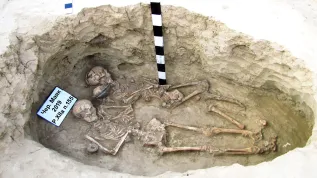
The currently used Indo-European languages evolved from the 5,000-year-old culture that initiated migrations through Eurasia, connecting Europe in the west with China and India in the east, new palaeogenetic research shows.
The study conducted by scientists from the Adam Mickiewicz University shed new light on the life of people who formed ancient communities and their migrations. Three thematically related papers co-authored by Dr. Marta Krenz-Niedbała and Dr. Sylwia Łukasik from the Faculty of Biology appeared in the latest issue of Science.
The papers provide data on the entire genomes of 727 ancient individuals from the so-called Southern Arc region, stretching from the Caucasus and Levant, through Anatolia and the Aegean region to the Balkans, connecting Europe and Asia.
The results conducted by an international team of scientists allowed them to fill gaps in the palaeogenetic record of the Eurasian population. It turned out, for example, that south-eastern Europe is inhabited by people genetically identical to the steppe population.
Dr. Krenz-Niedbała said: “New information, obtained thanks to the participation of scientists from around the world, concerns the directions of migrations, the formation of ancient communities in the Southern Arc region, the spread of Indo-European languages and the patterns of population interbreeding from several thousand years ago until the Middle Ages.”
Research has shown that all Indo-European languages spoken today can be traced back to the steppe shepherds of the Pit Grave culture, descendants of hunter-gatherers from the Caucasus and the East.
Dr. Sylwia Łukasik added: “Their expansion to the south included the Balkans and Greece, and in the east, through the Caucasus, they reached Armenia.
“During these migrations, descendants of steppe migrants mixed with local populations, and their influence is particularly noticeable in south-eastern Europe, where people genetically identical to the steppe population live.”
The researchers from the Adam Mickiewicz University conducted anthropological analyses of individuals from archaeological sites in Moldova and participated in the preparation of manuscripts.
The research was conducted under the supervision of Professor Ron Pinhasi from the University of Vienna, Professor Songül Alpaslan-Roodenberg from the University of Vienna and Harvard University, as well as Dr. Iosif Lazaridis and Professor David Reich from Harvard University.
Full texts of articles are available here, here, and here.
PAP - Science in Poland
kol/ agt/ kap/
tr. RL













